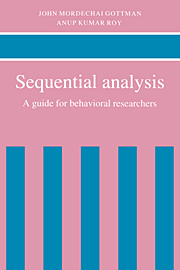Book contents
- Frontmatter
- Contents
- Preface
- Reading this book quickly
- Part I Introduction
- Part II Fitting the timetable
- Part III The timetable and the contextual design
- Chapter 10 Log-linear models
- Chapter 11 Log-linear models: review and examples
- Chapter 12 A single case analysis of the timetable
- Chapter 13 Logit models and logistic regression
- Chapter 14 The problem of autocontingency and its solutions
- Chapter 15 Recent advances: a brief overview
- Chapter 16 A brief summary
- References
- Index
Chapter 12 - A single case analysis of the timetable
from Part III - The timetable and the contextual design
Published online by Cambridge University Press: 10 November 2009
- Frontmatter
- Contents
- Preface
- Reading this book quickly
- Part I Introduction
- Part II Fitting the timetable
- Part III The timetable and the contextual design
- Chapter 10 Log-linear models
- Chapter 11 Log-linear models: review and examples
- Chapter 12 A single case analysis of the timetable
- Chapter 13 Logit models and logistic regression
- Chapter 14 The problem of autocontingency and its solutions
- Chapter 15 Recent advances: a brief overview
- Chapter 16 A brief summary
- References
- Index
Summary
Many applications of sequence analysis demand an overall procedure in which the same set of analyses is done for each case (subject, dyad, family, group) in our study. Most of our book is designed with such an application in mind. For example, we will usually want to know, for all the married couples in the study, which one “best” order of the Markov chain to pick, and, in general, how many segments are meaningful for dividing conversations in a stationarity analysis. This is the usual practice, because results would be difficult to report a case at a time.
However, in part to illustrate the flexibility of the methods we have mentioned, we will present a worked everyday example of the analysis of one couple using log-linear methods. We selected a case that has limitations in the amount of data available and that illustrates how much artfulness is needed to select a best model.
This chapter is best thought of as: (1) a worked example of log-linear methods; and as (2) an approach to hypothesis generating with sequential methods.
A Six-Step Procedure
Remember that the goal is to find the simplest model smaller than the fully saturated model that fits, that is, produces nonsignificant chi square. For example, if a Markov (1) (first-order Markov) model produces a significant chi square, this is evidence of the inadequacy of the model. The example will also illustrate how to cope with practical problems that can emerge from a model-fitting procedure.
Information
- Type
- Chapter
- Information
- Sequential AnalysisA Guide for Behavorial Researchers, pp. 168 - 188Publisher: Cambridge University PressPrint publication year: 1990
